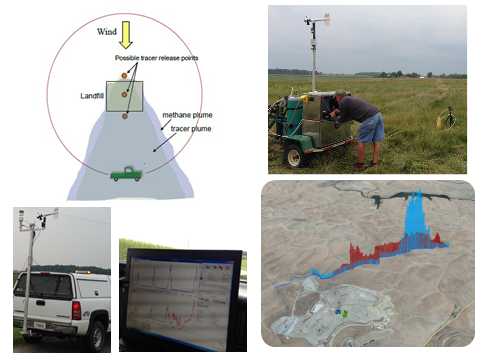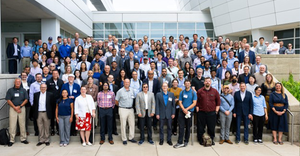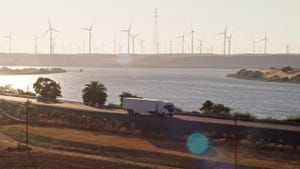How Landfill Gas Measurement Techniques Work

With the ongoing push to reduce greenhouse gas emissions, researchers and the solid waste industry are spending time and money developing methods to measure landfill methane emissions—not only to be able to quantify landfills’ contributions to greenhouse gases, but to have a way to assess whether technologies and processes for emission reduction are working, and to quantify progress.
Waste360 talked with Tarek Abichou, a professor of Civil and Environmental Engineering at Florida State University, who has been at the forefront of a considerable amount of the research and resulting innovations. He explains some of the gas emission techniques; how they work in what scenarios; and he talks about techniques that show future promise.
Waste360: What are some of the main landfill gas measurement techniques that you have researched?
Tarek Abichou: Some methods we have researched that have been extensively used over time are 1) flux chambers, which measure gas from point sources (very small areas; 1 m by 1 m max) ; 2) vertical radial plume mapping (VRPM), which measures area sources (1 to 5 acres); 3) tracer gas correlation, which measures whole-landfill emissions; 4) ambient air landfill surface measurements using a gas detector, which estimates area sources and or whole-landfill emissions.
Waste360: Can you provide more detail on how each technique works; benefits and drawbacks, starting with flux chamber measurements?
Tarek Abichou: The flux chamber method involves placing chambers, which are small containers or enclosures, at various points on the landfill surface to collect gas.
The concentration of gas in the chamber is monitored over time to assess its accumulation inside the chamber. The rate of gas accumulation is then used to calculate an emission flux.
The flux chamber is a direct emission technique, measuring flux directly, thus providing a more accurate reading of how much gas comes out in a given time. It is also the most low-tech method and therefore readily available for many landfills.
But this technique is very labor intensive as it requires several tests on all areas of the landfill. Our research team has developed a geo-spatial method to be used in conjunction with the chambers data to extend point measurements of emissions obtained from the chambers to estimate total landfill emissions. This will allow operators to report whole-landfill emissions.
Waste360: Before we move on to the other techniques, can you elaborate on this comment: “Chamber techniques can be run as static or dynamic chamber”?
Tarek Abichou:There are two ways of performing the chamber measurements. A static chamber is when we just place the container and monitor gas buildup inside the chamber. Based on our experience, static chambers are adequate. And they are easier to work with than dynamic chambers.
But for hydrogen sulfide(H2S) emissions, we should use a dynamic technique because H2S is not as stable as methane. For dynamic chambers, we need to sweep nitrogen through a chamber continuously during measurements; therefore, we do not allow buildup of gas, and we avoid underestimating emissions. With static chambers, there are companies now selling automated chambers that you can set up to run by themselves.
Waste360: Now can you explain vertical radial plume mapping (VRPM), tracer gas correlation, and ambient surface area measurements using a gas detector?
Tarek Abichou: The VRPM measures emissions from relatively flat, small area sources such as sewage ponds and composting facilities.
During our work with Waste Management and the Environmental Research and Education Foundation (EREF), my team and I used a laser to characterize the methane plume crossing the vertical plane, downwind from different areas of a landfill. The scanned plume is then combined with wind direction and wind speed to obtain an emission rate from the area upwind from the vertical plane. So basically, the laser scanning the vertical plane allows the measurement of gas emitted from the area upwind of that plane.

VPRM Gas Measurement
As landfills are large and have challenging topography, several VRPM set-ups are needed to characterize emissions from all areas of the landfill. Our team developed a method to assign emission rates to different areas of the landfill and combined theses individual VRPM setups to get whole-landfill emission estimates.
It is important to be able to assign contributions from each area because emissions are not uniform across the whole landfill. We have developed a way to determine accuracy levels of each measurement. This method not only gives us a better sense of emissions across the landfill; it also tells us what areas these emissions are coming from and how each area is contributing to emissions.
Then there is the tracer correlation method that our team worked on with Waste Management and the Environmental Protection Agency (EPA). This method allows for estimating the emission rate, and it is referred to as a whole-landfill emissions measurement technique because it allows for estimating emissions from the entire landfill in one measurement.
Amongst all currently available methods, the tracer release-based estimates of total emissions is considered to be the most accurate method.

Tracer gas measurement method
Tracer-based methods involve the controlled release of inert tracer gas from points of the emitting surface (landfill). Tracer methods avoid the issue of spatial heterogeneity by integrating the whole area flux and are therefore a preferred method for estimating emissions for whole landfills.
Due to the high cost of the controlled tracer release method, our team developed a modified version to estimate total emissions from large sources without the need for a tracer, which makes the process less expensive and easier. These simpler tests have shown to yield acceptable results.
Let’s move on to the method to measure ambient air surface methane concentrations using a sensor such as a portable flame ionization detector (FID).
This method is very easy and cheap and relies on the fact that landfills are required to monitor ambient air surface methane concentrations at their landfills. Since they will do this anyway, we can combine the concentration that these operators measure with air dispersion modeling using meteorological data such as wind direction and speed. This enables us to obtain estimates of emissions.

Waste360: What are some of the most promising and new evolutions you have worked on at the university?
Tarek Abichou: Promising new techniques include obtaining landfill emissions estimates using above-ground methane concentration measurements leveraging sensors such as laser or LIDAR. These measurements are obtained by scanning the surface of the landfill via walking, driving or by flying a drone on the surface of the landfill.
Each of the methods I’ve discussed to this point is so expensive. Plus measurements vary over time and are affected by seasonal variations. Therefore, the more we can measure them the better. So anything that reduces the cost of measuring emissions will lead to more methane emission data collection. And drones, which are relatively inexpensive to fly, could be part of the solution.
About the Author
You May Also Like




